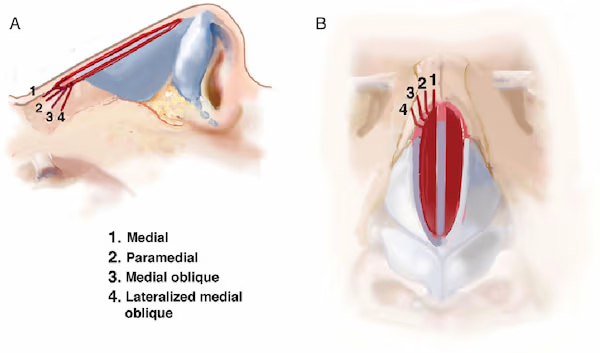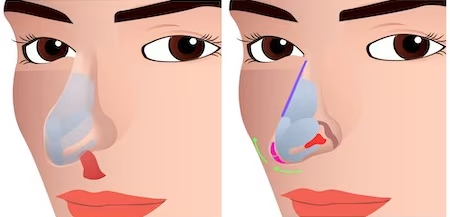For many individuals in Singapore, the shape and structure of their nose can significantly impact their facial harmony and self-confidence.
Nose bridge plasty has emerged as a popular cosmetic procedure that specifically addresses concerns related to the nasal bridge, helping achieve a more balanced facial appearance while potentially resolving functional issues that affect quality of life.
This comprehensive guide explores everything you need to know about nose bridge plasty in Singapore—from understanding what it entails and who makes an ideal candidate to the different techniques available, recovery expectations, and important considerations for selecting the right surgeon.
What Is Nose Bridge Plasty?

Nose bridge plasty, also referred to as nose augmentation or nose bridge enhancement, is a specialized cosmetic surgical procedure designed to reshape the bridge of the nose, creating a more proportionate and aesthetically pleasing facial profile.
Unlike a complete rhinoplasty which addresses multiple aspects of the nose, bridge plasty focuses specifically on modifying the height, width, or alignment of the nasal bridge.
In Singapore’s diverse population, this procedure has gained significant popularity, particularly among those with East Asian facial features who may desire a more prominent nose bridge to enhance their overall facial structure.
A low or flat nose bridge can make the face appear wider, potentially creating the impression that the eyes are positioned further apart.
Similarly, a crooked or asymmetrical nose bridge not only affects facial harmony but can also lead to functional problems including:
- Breathing difficulties
- Chronic rhinitis (nasal inflammation)
- Nasal congestion
- Sleep disturbances
- Sinus issues
Nose bridge plasty aims to correct these concerns by creating a sleeker, more defined nasal profile that complements the patient’s facial features while potentially improving nasal function for enhanced comfort and wellbeing.
You might be interested: Nose Fillers and Nose Threadlifts in Singapore
Types of Nose Bridge Plasty Available in Singapore
When considering nose bridge plasty in Singapore, patients typically have two primary options, each addressing different concerns and utilizing distinct surgical approaches:
1. Nose Bridge Implant
This procedure is specifically designed to heighten a low nose bridge, addressing the flat facial profile that may make the mouth appear more protruded.
By increasing the bridge height, the surgeon creates more definition and structure to the face, enhancing overall facial harmony.
The nose bridge implant procedure can be performed using either:
- Open incision technique: Involves making a small incision on the columella (the tissue between the nostrils), providing the surgeon with greater visibility but leaving a tiny external scar that typically fades over time.
- Closed incision technique: All incisions are made inside the nostrils, resulting in no visible external scarring but potentially offering slightly less surgical precision for complex cases.
The choice between these approaches depends on the patient’s specific nasal anatomy, desired outcome, and the surgeon’s recommendation based on technical requirements.
2. Osteotomy

Osteotomy is performed to trim or reposition the nose bridge, making it particularly suitable for:
- Hooked nose bridges
- Wide nose bridges
- Crooked or asymmetrical nasal structures
This technique involves controlled fracturing and realignment of the nasal bones to create a straighter, more refined nasal bridge. Depending on the patient’s unique condition, osteotomy may be performed:
- Bilaterally (addressing both sides of the nose)
- Unilaterally (focusing on a specific area of asymmetry)
- In combination with implant placement for comprehensive enhancement
Osteotomy is especially recommended for patients with bumpy or irregular nose bridges, as these features can create an aged or harsh appearance.
By smoothing and straightening the bridge, the procedure can contribute to a more youthful, gentle aesthetic.
Related article: Dermal Fillers in Singapore: The Comprehensive Guide
How Nose Bridge Plasty Works

Understanding the surgical process for each type of nose bridge plasty can help patients make more informed decisions about their treatment options.
Nose Bridge Implant Procedure
The implant procedure typically follows these steps:
- Anesthesia administration: Either local anesthesia with sedation or general anesthesia, depending on the case complexity and patient preference.
- Implant material selection: The surgeon selects an appropriate material, which may include:
- Medical-grade silicone (most common in Singapore)
- Gore-Tex (expanded polytetrafluoroethylene)
- Other biocompatible synthetic materials
- Custom implant shaping: The implant is meticulously carved and shaped according to the patient’s specific nasal contours, considering the entire facial profile from forehead to nose tip.
- Surgical insertion: The surgeon creates precise incisions (either internal or external, depending on the chosen approach) and develops a pocket along the nasal bridge.
- Implant positioning: The custom-shaped implant is carefully inserted and positioned to create the desired height and contour.
- Closure and securing: The incisions are sutured closed, and the implant is secured in its proper position.
The entire procedure typically takes between 1-2 hours, depending on complexity and whether additional nasal modifications are being performed simultaneously.
You might like: The Complete Guide to Facelift in Singapore
Osteotomy Procedure
For osteotomy procedures, the approach varies based on the specific nasal concern being addressed:
- For straightening a crooked nose bridge:
- The surgeon accesses the nasal bones through incisions typically made inside the nose
- Specialized instruments are used to create precise fractures in the misaligned bone segments
- The nasal bones are carefully repositioned into proper alignment
- Internal splints or packing may be placed to maintain the new structure
- External splints or casts help protect the nose during the initial healing phase
- For correcting a deviated nasal septum with osteotomy:
- The nasal septum cartilage is separated from the surrounding bone
- The deviated portion is repositioned to create a straighter nasal passage
- Supporting structures may be added to maintain the new alignment
- For addressing a bent nasal septum cartilage:
- The affected cartilage may be partially removed
- Remaining cartilage is reshaped and repositioned
- Structural grafts may be added for support if necessary
Osteotomy procedures typically take 1-3 hours, depending on the complexity of the case and whether additional techniques are being employed simultaneously.
You might want to read: Face Slimming Treatments in Singapore: Achieve a V-Shaped Face Without Surgery
Why People Choose Nose Bridge Plasty in Singapore
Individuals in Singapore seek nose bridge plasty for various reasons, ranging from purely aesthetic concerns to functional improvements:
Aesthetic Motivations
Many patients pursue nose bridge plasty to enhance their appearance by:
- Creating facial harmony: A well-proportioned nose bridge can balance facial features and create more pleasing proportions
- Increasing definition: A higher, more defined bridge adds structure and character to the face
- Addressing cultural preferences: In many Asian cultures, a higher nose bridge is considered an attractive facial feature
- Correcting asymmetry: Straightening a crooked or uneven nose bridge can significantly enhance overall facial symmetry
- Reducing signs of aging: Smoothing a bumpy or irregular bridge can contribute to a more youthful appearance
Related article: The Ultimate Guide to Thread Lifts in Singapore
Functional Improvements
Beyond aesthetics, many patients experience significant functional benefits, including:
- Enhanced breathing: Correcting structural abnormalities can improve airflow and reduce chronic congestion
- Reduced nasal discomfort: Addressing internal structural issues can alleviate chronic irritation or pressure
- Improved sleep quality: Better nasal airflow often contributes to reduced snoring and more restful sleep
- Decreased sinus problems: Proper nasal structure can improve sinus drainage and reduce infection risk
Psychological Benefits
The psychological impact of nose bridge plasty should not be underestimated:
- Increased self-confidence: Many patients report feeling more comfortable and confident in social and professional situations
- Reduced self-consciousness: Addressing a perceived flaw can significantly reduce anxiety about appearance
- Improved quality of life: The combination of aesthetic improvement and functional benefits often enhances overall wellbeing
Post-Trauma Correction
For individuals who have experienced nasal injuries:
- Restoration of pre-injury appearance: Repairing damage from accidents or physical trauma
- Correction of breathing difficulties: Addressing structural damage that impairs normal nasal function
- Psychological healing: Resolving a visible reminder of a traumatic event
Ideal Candidates for Nose Bridge Plasty
Not everyone is an ideal candidate for nose bridge plasty. The procedure is most suitable for individuals who:
Have Specific Nasal Concerns
- Low or flat nose bridge that creates a less defined facial profile
- Crooked or asymmetrical nose bridge due to genetics or previous injury
- Hooked nose bridge that creates an aged or harsh appearance
- Wide nose bridge that lacks refinement
- Previously placed implant that has shifted or appears unnatural
Meet Health Requirements
- Are in good overall physical health without conditions that may impair healing
- Do not have active skin infections in the nasal area
- Have no uncontrolled bleeding disorders
- Do not have significant allergies to potential implant materials
- Have realistic expectations about surgical outcomes
Age Appropriately
- Have completed facial growth (typically 18+ years)
- Have skin with adequate elasticity to adapt to the new structure
- Do not have age-related health concerns that might increase surgical risks
Lifestyle Factors
- Non-smokers or willing to stop smoking for several weeks before and after surgery
- Able to take adequate time off for proper recovery
- Willing to follow post-operative care instructions diligently
- Psychologically prepared for both the recovery process and adapting to their new appearance
A thorough consultation with a qualified plastic surgeon is essential to determine if you’re an appropriate candidate for nose bridge plasty based on your unique anatomy, health status, and aesthetic goals.
You might be interested: Comprehensive Guide to Cheek Fillers in Singapore
Comparing Nose Bridge Plasty and Full Rhinoplasty
While nose bridge plasty and rhinoplasty are related procedures, they differ significantly in scope, approach, and recovery expectations. Understanding these differences can help patients choose the option that best addresses their specific concerns.
| Aspect | Nose Bridge Plasty | Full Rhinoplasty |
|---|---|---|
| Focus Area | Primarily the bridge of the nose | Entire nose structure (bridge, tip, nostrils, etc.) |
| Complexity | Generally less complex | More comprehensive modification |
| Surgical Time | Typically 1-2 hours | Often 2-4 hours |
| Recovery Period | Usually 1-2 weeks before returning to normal activities | Typically 2-3 weeks, with residual swelling for months |
| Anesthesia | Often possible with local anesthesia and sedation | Frequently requires general anesthesia |
| Suitable For | Specific bridge concerns (height, straightness) | Comprehensive nasal reshaping needs |
| Visible Results | Final results apparent within 1-3 months | Final refinement may take 6-12 months |
Many patients find that nose bridge plasty adequately addresses their concerns without requiring the more extensive intervention of a full rhinoplasty. However, those with multiple nasal concerns affecting different areas may benefit from the more comprehensive approach.
The Consultation Process
A thorough consultation is the crucial first step in your nose bridge plasty journey. During this appointment, you can expect:
Assessment of Your Nasal Structure
The surgeon will carefully examine your:
- Current bridge height and width
- Nasal bone structure and alignment
- Skin thickness and elasticity
- Overall facial proportions and symmetry
- Internal nasal passages if functional concerns are present
Discussion of Your Goals
Be prepared to clearly communicate:
- What specifically bothers you about your nose bridge
- The changes you hope to achieve
- Your expectations for improvement
- Any functional issues you’re experiencing
- Previous nasal surgeries or treatments
Evaluation of Your Medical History
The surgeon will review:
- General health status
- Previous surgeries
- Current medications
- Allergies
- Bleeding or healing disorders
- Smoking status
Presentation of Options
Based on your anatomy and goals, the surgeon will discuss:
- Whether implant placement, osteotomy, or a combination approach is recommended
- Implant material options if relevant
- Expected outcomes and limitations
- Potential risks and complications
- Recovery timeline
Photography and Imaging
Most consultations include:
- Detailed photographs from multiple angles
- Possibly computer imaging to visualize potential results
- Measurements for surgical planning
Financial Discussion
You’ll receive information about:
- Procedure costs
- Payment options
- Whether any portion might be covered by insurance (rare, except for certain functional corrections)
Come prepared with questions about the surgeon’s experience, before-and-after photos of previous patients, and any concerns you may have about the procedure or recovery.
You might like: Types of Non-Surgical Facelifts in Singapore
Procedure Techniques in Detail
Pre-Surgical Preparation
Before undergoing nose bridge plasty, patients typically need to:
- Complete any requested medical tests or evaluations
- Avoid aspirin, anti-inflammatory medications, and certain supplements for 2 weeks
- Stop smoking at least 2 weeks before surgery (longer is better)
- Arrange for transportation home after the procedure
- Prepare a recovery area with necessary supplies
- Follow fasting guidelines before anesthesia
Surgical Approaches
For Implant Procedures:
Open Approach:
- A small incision is made across the columella (tissue between nostrils)
- The skin is carefully lifted to expose the nasal structure
- The implant is precisely positioned and secured
- The incision is meticulously closed with fine sutures
- Offers maximum visibility but leaves a small external scar
Closed Approach:
- All incisions are made inside the nostrils
- The implant is inserted through these internal incisions
- No visible external scarring
- May offer slightly limited visibility for complex cases
- Often preferred for straightforward augmentation
For Osteotomy Procedures:
Lateral Osteotomy:
- Fractures are created on the sides of the nasal bones
- Allows narrowing of a wide nose bridge
- Helps straighten certain types of crooked bridges
Medial Osteotomy:
- Fractures are created in the center of the nasal bridge
- Helps correct certain bridge irregularities
- Often used in combination with lateral osteotomy
Intermediate Osteotomy:
- Additional fractures between lateral and medial osteotomies
- Provides more precise control over bone repositioning
- Used for more complex bridge irregularities
Implant Materials
When implants are used, patients in Singapore typically have several material options:
Silicone Implants:
- Most commonly used in Singapore
- Smooth, flexible, and easily shaped
- Simpler to remove if necessary
- Relatively affordable
- Long track record of safety
- Small risk of shifting over time
Gore-Tex (ePTFE):
- Porous structure allows tissue integration
- Extremely stable once healed
- Very natural feel
- Slightly higher cost
- More difficult to remove if needed
Medpor:
- High-density porous polyethylene
- Excellent tissue integration
- Very stable long-term results
- Higher cost
- Rarely used for primary bridge augmentation
Your surgeon will recommend the most appropriate material based on your anatomy, aesthetic goals, and specific requirements.
Recovery and Aftercare
The recovery process after nose bridge plasty follows a fairly predictable timeline, though individual experiences may vary based on the specific techniques used and personal healing factors.
Immediate Post-Surgery Period (First 24-48 Hours)
- A splint or cast is typically applied to protect the nose
- Internal packing may be placed to control bleeding (removed within 24-48 hours)
- Significant swelling and bruising around the eyes and nose is normal
- Pain is usually moderate and manageable with prescribed medication
- Head must be kept elevated, even while sleeping
- Cold compresses may be applied to reduce swelling (following surgeon’s instructions)
- Limited activity is strongly advised
First Week
- Most patients take 5-7 days off work
- External splint or cast is typically removed around day 7
- Bruising peaks and begins to subside
- Swelling remains significant but begins to improve
- Breathing through the nose may be difficult due to internal swelling
- No blowing your nose, bending over, or strenuous activity
- Sleep with head elevated to minimize swelling
- Follow specific cleaning instructions provided by your surgeon
- Take antibiotics as prescribed to prevent infection
Weeks 2-3
- Most visible bruising resolves
- Swelling continues to decrease but remains noticeable
- Breathing through the nose improves
- Most patients return to work and light social activities
- Avoid strenuous exercise, swimming, and activities that risk nasal injury
- Continue to sleep with head slightly elevated
- Sun protection becomes crucial (high SPF, hat when outdoors)
Weeks 4-6
- External appearance continues to refine as swelling subsides
- Most normal activities can be resumed
- Light exercise may be permitted (following surgeon’s guidance)
- Still avoid contact sports or activities with high injury risk
- Implants begin to settle into their final position
- Follow-up appointment to assess healing
Months 2-6
- Subtle swelling continues to resolve
- Final results begin to emerge
- Sensitivity gradually decreases
- Most activities can be resumed with surgeon’s approval
- Internal healing continues
- Regular follow-up to monitor progress
Long-term Care
For optimal long-term results:
- Protect your nose from sun exposure (SPF 30+ recommended)
- Avoid direct impact to the nose
- Follow any specific long-term care instructions from your surgeon
- Report any concerns promptly
- Maintain general health for optimal healing
Potential Risks and Complications
As with any surgical procedure, nose bridge plasty carries certain risks that patients should understand before proceeding:
General Surgical Risks
- Infection at incision sites
- Bleeding or hematoma formation
- Adverse reaction to anesthesia
- Poor wound healing or scarring
- Prolonged swelling or pain
Implant-Specific Risks
- Implant displacement or shifting
- Implant extrusion (pushing through skin)
- Visible or palpable implant edges
- Foreign body reaction
- Need for implant replacement or removal
Osteotomy-Specific Risks
- Nasal asymmetry after healing
- Irregularities in bone healing
- Under-correction or over-correction
- Change in breathing function
- Need for revision surgery
Aesthetic Concerns
- Unsatisfactory aesthetic outcome
- Unnatural appearance
- Asymmetry
- Persistent swelling
- Visible scarring (primarily with open approach)
Functional Issues
- Altered breathing patterns
- Nasal obstruction
- Chronic nasal dryness or congestion
- Changes in sense of smell (rare)
Working with a board-certified plastic surgeon with specific expertise in nose procedures significantly reduces these risks. Following all pre-operative and post-operative instructions also plays a crucial role in minimizing complications.
Choosing the Right Surgeon in Singapore
The success of your nose bridge plasty depends significantly on selecting the right surgeon. In Singapore, where cosmetic surgery has become increasingly sophisticated, consider these key factors:
Qualifications and Credentials
- Look for board certification in plastic surgery or otolaryngology (ENT)
- Verify specialized training in facial plastic surgery
- Check membership in professional organizations like the Singapore Association of Plastic Surgeons
- Confirm hospital privileges at reputable institutions
- Research the surgeon’s educational background and continuing education
Experience and Expertise
- Inquire about the number of nose procedures performed annually
- Ask specifically about experience with your ethnic background and facial structure
- Review before-and-after photos of previous patients with similar concerns
- Seek a surgeon who regularly performs both implant and osteotomy techniques
- Consider how long the surgeon has been specializing in nasal procedures
Communication Style
- The surgeon should listen carefully to your concerns and goals
- Look for clear explanations of options, risks, and realistic outcomes
- Avoid surgeons who dismiss your questions or concerns
- Ensure you feel comfortable discussing your hopes and fears
- The surgeon should neither over-promise nor be unnecessarily negative
Facility Standards
- Verify that procedures are performed in accredited surgical facilities
- Check that proper emergency protocols are in place
- Confirm the qualifications of the anesthesia providers
- Ensure the practice follows strict sterilization and safety standards
- Consider whether the facility seems clean, organized, and professional
Review Research
- Read patient reviews and testimonials
- Check for any disciplinary actions or complaints
- Ask for referrals from previous patients if possible
- Consult with your primary care physician for recommendations
- Consider reputation among other medical professionals
Trust Your Instincts
- Pay attention to how staff treats you
- Notice whether your concerns are taken seriously
- Consider whether the recommended approach aligns with your goals
- Ensure you never feel pressured into additional procedures
- Remember that a good surgical relationship is built on trust and respect
Multiple consultations with different surgeons are highly recommended before making your final decision.
Cost Considerations in Singapore
The cost of nose bridge plasty in Singapore varies widely based on several factors:
Price Ranges
- Basic nose bridge implant: SGD 3,500 – 7,000
- Osteotomy procedures: SGD 6,000 – 12,000
- Combined techniques: SGD 8,000 – 15,000
Factors Affecting Cost
- Surgeon’s expertise and reputation: More experienced surgeons typically command higher fees
- Facility type: Hospital-based procedures cost more than clinic-based surgeries
- Anesthesia approach: General anesthesia increases costs compared to local with sedation
- Implant materials: Premium materials like Gore-Tex may add to the overall expense
- Procedure complexity: Combined techniques or revision surgeries cost more
- Post-operative care package: Comprehensive aftercare services may affect total price
What’s Typically Included
A comprehensive nose bridge plasty package should include:
- Pre-surgical consultations
- Surgeon’s fee
- Anesthesia costs
- Facility charges
- Basic post-operative medications
- Standard follow-up appointments
- Removal of sutures or splints
What May Cost Extra
Be prepared for potential additional expenses:
- Pre-surgical medical clearance or tests
- Prescription medications beyond basics
- Additional follow-up visits beyond standard care
- Revision procedures if needed
- Treatment of complications
- Special post-operative supplies
Insurance Considerations
Most health insurance plans in Singapore classify nose bridge plasty as a cosmetic procedure and do not provide coverage. However, if the surgery addresses functional issues like breathing difficulties due to structural abnormalities, partial coverage may be possible. Always check with your insurance provider before proceeding.
Financing Options
Many plastic surgery practices in Singapore offer:
- Interest-free payment plans
- Medical financing through third-party companies
- Credit card payment options
- Packaged pricing for combined procedures
While cost is an important consideration, it should never be the primary factor in selecting your surgeon. The expertise, safety record, and consistent results of your chosen practitioner will ultimately determine your satisfaction with the procedure.
Frequently Asked Questions
General Questions
Q: How long has nose bridge plasty been performed in Singapore? A: Nose bridge plasty has been performed in Singapore for decades, but techniques have evolved significantly in the past 15-20 years with the development of better implant materials and more refined surgical approaches.
Q: Is nose bridge plasty permanent? A: Yes, the results of nose bridge plasty are generally permanent, though natural aging may cause subtle changes over time. Implants typically remain in place indefinitely unless complications arise requiring removal or replacement.
Q: Can nose bridge plasty be combined with other procedures? A: Absolutely. Many patients combine nose bridge plasty with other facial procedures such as alarplasty (nostril reshaping), tip plasty, chin augmentation, or even non-surgical treatments like fillers for comprehensive facial enhancement.
Q: How noticeable will the changes be after nose bridge plasty? A: The degree of change depends on your starting point and goals. Most patients experience noticeable improvement while maintaining a natural appearance. A skilled surgeon can create changes that enhance your features without appearing obviously “surgical.”
Procedure-Specific Questions
Q: What’s the difference between silicone and Gore-Tex implants? A: Silicone implants provide a firmer, more defined contour and are easier to remove if necessary, making them popular in Singapore.
Gore-Tex has a porous structure that allows tissue integration for a very stable, natural feel but is more difficult to remove if needed.
Q: Can nose bridge plasty correct breathing problems? A: Yes, particularly when osteotomy techniques are used to straighten a crooked nose or when combined with septoplasty.
However, if breathing improvement is your primary goal, discuss this explicitly with your surgeon, as some techniques focus more on aesthetics than function.
Q: Will I need to replace my implant in the future? A: Most quality implants do not require replacement if properly placed and if no complications occur. However, a small percentage of patients may require adjustment or replacement due to shifting, infection, or dissatisfaction with the aesthetic result.
Q: Is it possible to adjust the height of my implant after surgery if I’m not satisfied? A: Yes, revision surgery is possible to replace an implant with one of a different size or shape.
However, this requires allowing complete healing from the original procedure (typically 6-12 months) before undergoing revision.
Recovery Questions
Q: How long will I need to take off work? A: Most patients take 7-10 days off work for nose bridge plasty. Those with jobs requiring physical exertion may need two weeks or more.
If you’re concerned about visible bruising or swelling, plan for up to two weeks before returning to public-facing positions.
Q: When can I resume exercise after nose bridge plasty? A: Light walking can usually be resumed within a week. More strenuous cardiovascular exercise should wait 2-3 weeks.
Contact sports or activities with high risk of nasal injury should be avoided for at least 6 weeks, potentially longer based on your surgeon’s recommendation.
Q: How long will the swelling last? A: Initial significant swelling typically subsides within 2-3 weeks. However, subtle swelling can persist for several months, with final refinement continuing for up to a year, particularly at the bridge.
Most patients find that the majority of noticeable swelling resolves within the first month.
Q: When can I wear glasses after nose bridge plasty? A: You should avoid placing anything on your nose bridge, including glasses, for approximately 6 weeks after surgery to prevent shifting of the tissues or implant.
Your surgeon can provide special tape or props that allow glasses to rest on your cheeks instead during recovery.
Risk and Safety Questions
Q: What is the risk of implant rejection? A: True implant rejection is rare with modern materials.
However, implant extrusion (where the implant pushes through the skin) or infection may occur in a small percentage of cases, particularly with improper placement or inadequate tissue coverage.
Q: Are there any long-term health risks associated with nasal implants? A: Quality implant materials used in Singapore have excellent safety profiles with minimal long-term health concerns.
Silicone and Gore-Tex have been used for decades with good safety records. The most common long-term issue is aesthetic (shifting or visibility) rather than health-related.
Q: What happens if I’m unhappy with my results? A: If you’re dissatisfied after complete healing (6-12 months), discuss your concerns with your surgeon. Minor adjustments may be possible with non-surgical treatments in some cases.
More significant concerns may require revision surgery, which can be more complex than the initial procedure.
Q: Can nose bridge plasty affect my sense of smell? A: Changes to sense of smell are rare with bridge-focused procedures but can occur temporarily due to swelling. Permanent changes to smell are extremely uncommon unless extensive internal work is performed.
Practical Considerations
Q: How do I find the best surgeon for nose bridge plasty in Singapore? A: Research board-certified plastic surgeons or otolaryngologists who specialize in nasal procedures, review before-and-after galleries, schedule multiple consultations, ask about complication rates and revision policies, and verify the surgeon’s experience with your specific ethnic background and facial structure.
Q: What age is appropriate for nose bridge plasty? A: Most surgeons recommend waiting until facial growth is complete, typically around 16-18 years of age.
However, many prefer patients to be at least 18 to ensure physical maturity and to confirm that the desire for the procedure is consistent over time.
Q: Will my insurance cover nose bridge plasty? A: Most insurance plans consider nose bridge plasty cosmetic and don’t provide coverage.
However, if functional breathing issues are documented and the procedure addresses these concerns, partial coverage may be possible. A thorough pre-surgical evaluation can help determine if any portion might qualify for coverage.
Q: How painful is recovery from nose bridge plasty? A: Most patients describe the recovery as uncomfortable rather than severely painful.
The most discomfort occurs in the first 48-72 hours and is typically well-managed with prescribed pain medication. Pressure and congestion sensations are common but generally not intensely painful.
Conclusion: Making Your Decision
Deciding whether nose bridge plasty is right for you requires careful consideration of your aesthetic goals, functional needs, health status, and expectations. In Singapore, where cosmetic surgery has reached sophisticated levels of artistry and safety, patients have access to excellent surgical options for enhancing their nasal profile.
The most successful outcomes come from:
- Thorough research: Understanding the procedure, techniques, and options available
- Realistic expectations: Recognizing the possibilities and limitations based on your unique anatomy
- Selecting the right surgeon: Prioritizing expertise and safety over cost considerations
- Proper preparation: Following all pre-surgical instructions carefully
- Diligent aftercare: Complying with all recovery guidelines for optimal healing
Take your time making this important decision. Consider seeking multiple professional opinions, and remember that the goal should be enhancement rather than perfection. The most natural-looking results often come from conservative, thoughtfully planned modifications that complement your existing facial features.
With the right approach and qualified surgical team, nose bridge plasty can provide a significant boost to both your appearance and confidence, creating harmony and balance that enhances your natural beauty for years to come.


 Nose bridge plasty in Singapore offers two main options: implant procedures to heighten a low bridge or osteotomy techniques to correct crooked, wide, or hooked bridges, with each addressing different aesthetic and functional concerns.
Nose bridge plasty in Singapore offers two main options: implant procedures to heighten a low bridge or osteotomy techniques to correct crooked, wide, or hooked bridges, with each addressing different aesthetic and functional concerns.